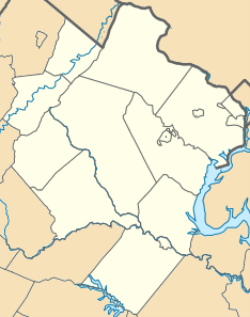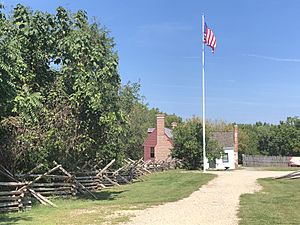Ferry Farm facts for kids
|
George Washington Boyhood Home Site
|
|

The replica house built on the site of the original Washington home at Ferry Farm
|
|
| Location | Stafford County, Virginia, U.S. |
|---|---|
| Nearest city | Fredericksburg, Virginia |
| Area | 68.8 acres (278,000 m2) |
| Built | 1738 |
| Architectural style | Central-passage house |
| NRHP reference No. | 72001417 |
Quick facts for kids Significant dates |
|
| Added to NRHP | May 5, 1972 |
| Designated NHL | February 16, 2000 |
Ferry Farm is the historic farm and home where George Washington lived for much of his childhood. It is also known as the George Washington Boyhood Home Site. This important place is located in Stafford County, Virginia, right next to the Rappahannock River. It sits across the river from the city of Fredericksburg, Virginia.
In 2008, archaeologists made an exciting discovery. They found the remains of George Washington's childhood home. This house had a fire around 1740. Among the items found were pieces of a fancy tea set. These likely belonged to George's mother, Mary Ball Washington.
By 2015, The George Washington Foundation started building a copy of Washington's boyhood home. It was built exactly where the original house stood. The new house was finished in 2018 and is now open for visitors to explore.
Contents
The History of Ferry Farm
This farm got its name, Ferry Farm, after the Washington family had moved away. It was named after a free ferry that crossed the Rappahannock River. This ferry used Washington family land, but the family did not own or run it. We don't know what the farm was called when the Washingtons lived there.
Later, in the late 1800s, the farm was sometimes called Pine Grove. It was also known as The Ferry Farm. The farm became very famous around 1932. This was during the 200th birthday celebration of George Washington.
Before George Washington Lived Here
For thousands of years, Native Americans lived on the land that is now Ferry Farm. Archaeologists have found many ancient tools. These include a spear point from over 10,000 years ago. They also found pottery made by early farmers.
The first European to claim this land was John Catlett in 1666. By 1710, the land was divided into smaller farms. Maurice Clark owned the part that became Ferry Farm. In 1727, William Strother bought the property. He was a lawyer and a leader in the new King George County.
In 1738, George Washington's father, Augustine, bought the farm. Augustine Washington was an important man. He held political jobs and owned several successful farms. He also helped manage an iron furnace nearby. He moved to Ferry Farm in the fall of 1738. He came with his second wife, Mary Ball Washington, and their five young children.
George Washington's Time at the Farm
George Washington lived in three main places during his life. He was born at Pope's Creek, Virginia, in 1732. From 1735 to 1738, his family lived at Little Hunting Creek. This place was later renamed Mount Vernon by his older brother, Lawrence.
The Washington family moved to Ferry Farm in 1738 when George was six years old. They called it the Home Farm. Their house was a 1½-story home with a central hallway. It sat on a bluff overlooking the Rappahannock River. George's father, Augustine, built this house.
Archaeologists found that the house was about 54 feet (16 m) wide and 28 feet (8.5 m) deep. George lived in this house until his early 20s. However, George Washington did not feel a strong connection to the farm. He saw it as a "crowded, busy, trouble-filled place."
When George's father, Augustine, died, he left behind some tools for surveying land. At age 16, George used these tools and loved it. Surveying became his first real passion. This skill helped him connect with his brother Lawrence and the powerful Fairfax family.
By age 18, George was given 453 acres of land in western Frederick County. He surveyed this land and bought more nearby. Soon, he owned almost two thousand acres in the west. This was much more land than Ferry Farm was worth. He often stayed with his half-brother Lawrence at Mount Vernon.
George's mother, Mary, lived at Ferry Farm until 1772. Then she moved to Fredericksburg. The farm was sold to a friend, Hugh Mercer. By 1833, the Washington-era house was falling apart.
After the Washington Family Left
In 1850, a new farmhouse was built for a farm manager. The area around Ferry Farm saw fighting during the American Civil War in 1862. Many battles happened near Fredericksburg. This was because of the ferries and train lines there.
Union soldiers often camped at Ferry Farm during the Civil War. They used it to get ready for battles. In 1862, President Abraham Lincoln visited Ferry Farm. Many soldiers carved small items from a tree they thought was from the famous cherry tree story. Much of the farm was damaged during this time.
Another new farmhouse was built in the 1870s, along with other farm buildings. A small "surveyor's shed" from this time still stands today.
Since the 1920s, many groups have tried to save and make money from the property. James Beverly Colbert tried to profit from its connection to Washington. A writer named George Allan England wrote ads to promote the land's history. He used many of the famous stories about Washington.
Colbert also claimed a small building, "The Surveyor Shed," was a real historical item, even though it wasn't. They hoped the land would sell quickly because George Washington's 200th birthday was coming. But other historical sites also wanted to be saved, and the Great Depression stopped their plans.
In later years, different groups tried to make Washington's boyhood home a "national shrine." In the 1960s, a home for troubled boys was built there. This project left a large building that now holds a museum, offices, and an archaeology lab. Visitors can see it since 2006.
In the 1990s, Stafford County leaders wanted to save the site and bring business. This led to a plan for Wal-Mart to buy the land next to the historic site. Many people in Fredericksburg were against this. They worried it would harm the town's historic views and tourist business.
Eventually, a deal was made. Historic Kenmore, the home of Washington's sister Elizabeth, bought the site. This was done with help from the National Park Service and state funds. Historic Kenmore became The George Washington Foundation in 2008. This foundation now manages Ferry Farm and Kenmore.
Ferry Farm was named a National Historic Landmark in 2000.
Archaeologists started digging extensively in 2002. They wanted to find and understand the original Washington farm. In 2008, they announced they found the original home site. It included the foundations of a 53 by 37 feet (11 m) house. This house had a small fire when George Washington lived there. In 2018, a copy of the original home was finished over these foundations. Guided tours are offered daily. Ferry Farm also has programs for children and other public events.
The site is located at 237 King's Highway (Virginia Route 3), near Fredericksburg.
Preserving Ferry Farm's History
Discoveries by Archaeologists
The George Washington Foundation bought the land in 1996. Since 2003, they have supported an archaeology field school there. Students and volunteers help dig and find artifacts each summer. They have found items from ancient times, the Civil War, and beyond.
Rebuilding George Washington's House
Between 2006 and 2008, archaeologists found the cellar of George Washington's boyhood home. This helped them find the exact spot of the house. They used the remains and artifacts to date the house to the 1740s. This was when the Washington family lived there.
In 2015, work began on a replica house. It was built over the original foundations. Builders used information from the archaeological finds. They also used old descriptions of the house and knowledge of other colonial Virginia homes. Experts used 18th-century building methods to construct the house. It was finished and opened to the public in 2018.
The house is filled with copies of furniture and objects. These are like the ones listed in Augustine Washington's inventory when he died in 1743. Visitors can touch and interact with everything in the house. This includes sitting on furniture and opening cabinets.
The Foundation and Museum
The George Washington Foundation now owns Ferry Farm. They also own Kenmore, the Fredericksburg home of Washington's sister Elizabeth. The Foundation gets money from donors and grants. They have managed the land since the Wal-Mart purchase.
They fund and manage the archaeological digs. They also plan to recreate the historical landscape. A new visitor's center is also planned for the site.
Ancient Times at Ferry Farm
Archaeologists have found artifacts at Ferry Farm from as far back as 10,000 B.C. This period of ancient artifacts continues until 1,500 B.C. These items include tools for hunting and gathering. Ancient people used them to hunt animals around the Rappahannock River. The land was rich in food sources and had many animals.
The different food sources meant people needed many types of tools. Examples of tools found include spear points, stone axes, and quartz scrapers.
Life Before European Settlers
Evidence is not as common for this period. But artifacts show that Woodland Indians lived around Ferry Farm from 1,500 B.C. to 1,500 A.D.
Colonial Life Discoveries
Many interesting items from the Colonial Period have been found. These include the ends of 18th-century wig hair curlers. These curlers were used to style wigs for George Washington's younger brothers. Wigs were a very expensive part of a wealthy man's clothing in the late 1700s.
Civil War Artifacts
The Civil War reached Ferry Farm in 1862. Many artifacts from the war have been found. These include bullets, ink bottles, and buttons from uniforms.
Stories and Myths of Ferry Farm
The Cherry Tree Story
Ferry Farm is the setting for some of the most famous stories about George Washington. These stories were made popular by Mason Locke Weems, also known as Parson Weems, in the early 1800s.
One famous story is about a 6-year-old George. He supposedly chopped down one of his father's favorite English cherry trees with a new hatchet. When his father asked about it, George confessed. He said, "I cannot tell a lie; I did it with my little hatchet."
George Washington's step-grandson, George Washington Parke Custis, shared another version of a story. In this one, young George tried to ride his mother's new horse. He rode the horse so hard that it died. Like the cherry tree story, George admitted what he had done.
Both stories show George Washington's honesty. They also share a theme of loss. Washington knew about loss after his father died and he couldn't study abroad.
The Silver Dollar Toss
Another story says that Washington "threw a silver dollar across the Rappahannock River." It is possible to skip a coin or flat rock across that part of the river. However, the river was much wider back then, making the feat harder.
Every year on Washington's Birthday, people are invited to try and repeat this throw. In 2006, an archaeology intern named Jim Trueman successfully threw a coin across. He did it again the next summer to prove it wasn't a lucky shot.
See also







